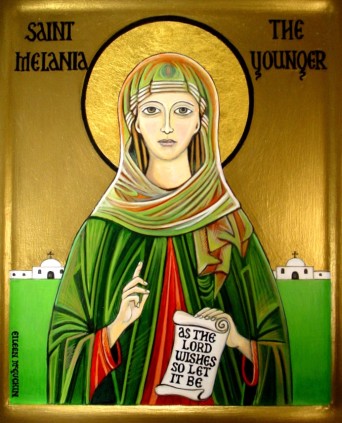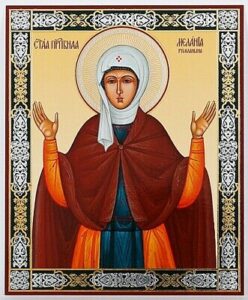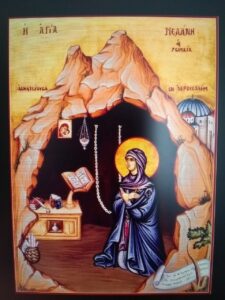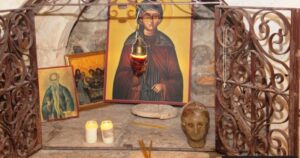
St. Melania the Younger was a wife and mother, a foundress of early monasteries, and a prolific philanthropist. In circa 383, Melania was born to parents of the wealthy Valerii family. Her father, Publicola, was a member of the Roman Senate, and her mother’s name was Albina. Both parents were Christian and the family lived in Rome. Melania’s paternal grandmother was also named Melania, known to us as St. Melania the Elder. It is unlikely that Melania had siblings, because her parents planned to arrange a marriage for her in order to pass on their substantial wealth. When she was fourteen, she married a patrician youth named Valerius Pinianus. From the outset, she requested of her husband that they live in continence so that she could dedicate her life entirely to God. He compromised with her to have two children to inherit the family wealth, after which they would live in continence. A daughter and a son were born of this union, but both died as babies. After the death of the second child, Melania became gravely ill. Pinianus made a vow to God that if she was to recover, he would agree to a life of perpetual continence. Melania did recover, and despite Publicola’s desire for an heir to the family fortune, Pinianus and Melania resolved to “live together as brother and sister” and dedicate their lives entirely to serving God.
HEIRESS TO PHILANTHROPIST

After her recovery, Melania began a long process of parting with her wealth. She ceased wearing her beautiful clothing and jewelry and dressed simply. A few years later, Publicola also became gravely ill. On his deathbed, he begged forgiveness of his daughter for the pressure he had imposed in his desire for an heir and gave his blessing for their chosen manner of life. After his death, Melania inherited his vast wealth, including estates in Italy, Spain, Sicily, and North Africa. Because of the Visigoth invasion of Italy, Pinianus, Melania, and her mother Albina left Rome in 403 for the island of Sicily. Melania began selling off her properties for charitable purposes, encountering opposition from influential relatives. She appealed to the Emperor Honorius, who granted her the right to disburse her estate as she wished. Pinianus and Melania rendered assistance to the poor, the imprisoned, and homeless former slaves. After the family estates in Italy and Spain were sold, she gave the funds to assist monastic communities and to establish churches, orphanages, and hospitals. The recipients of this philanthropy were located throughout the Empire, in such places as Mesopotamia, Syria, Palestine, Egypt, and Phoenicia. She managed to free nearly eight thousand slaves.
DEPARTURE FOR THE HOLY LAND
The trio left Sicily for North Africa, experiencing a shipwreck at the small island of Lipari. There, barbarians were holding the residents hostage, threatening to pillage and destroy. Melania ransomed the people, saving them from destruction. They proceeded to Thagaste, Numidia, where they met [St.] Augustine [of Hippo]. There, Melania founded a monastery for women and another for men. She lived with the women, and led them in a penitential life. She dedicated much of her time transcribing and distributing manuscripts of the holy books of Scripture. In 417, the trio set out for the Holy Land, stopping at Alexandria, where they were welcomed by the Bishop [St.] Cyril. They also visited the Egyptian desert monks. They arrived in Jerusalem, where Melania met her cousin [St.] Paula, who brought them to the Christian group being led by [St.] Jerome, with whom they became friends and provided assistance. There, Melania continued to disperse her wealth to the poor and lived mostly in seclusion in a cell on the Mount of Olives.

In 431, Albina died, and Pinianus died the following year. Melania built a monastery for women on the Mount of Olives, guiding them in lives of purity and prayer. In the monastery chapel, relics of the Prophet Zachariah and the first martyr St. Stephen were venerated. She also built a men’s monastery on the Mount of the Lord’s Ascension. She traveled to Constantinople to try to convert her pagan uncle, who did become a Christian, and she was known to have worked miracles there. While there, she actively sought to combat the Nestorian heresy, and converted many of its adherents. She died in Jerusalem on December 31, 439 at the approximate age of fifty-six.

St. Melania the Younger was venerated soon after her death in the Eastern Church, based in Constantinople, but was unknown in the Western Church, based in Rome. Cardinal Rampolla in 1884 discovered manuscripts which included her biography. Pope [St.] Pius X approved the observance of her December 31 feast day in 1908. The great St. Augustine of Hippo referred to Melania, along with her husband and mother, as “real lights of the Church”. Because she spent her lifetime giving away her immense wealth in support of Christ’s Kingdom, she is considered one of the greatest Church philanthropists of all time.
